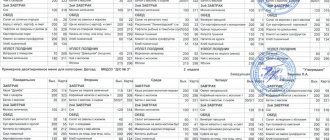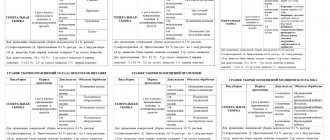What does it mean to be awake?
This is not just a period when the child does not sleep. The wakefulness of a preschooler attending kindergarten is filled with a variety of useful activities:
- walks (in winter - about 3 hours, in summer - up to 6);
- study of the surrounding world;
- physical activity;
- speech development classes;
- work activity;
- classes or games on mental development (mathematics, learning to read, logic, development of attention, memory), moral education;
- creative activity;
- music lessons;
- teaching writing skills.
Such activities directly contribute to the development of qualities that a child will definitely need at school: initiative, perseverance, concentration, activity, motor skills, curiosity, and the ability to withstand a certain amount of time at work.
For younger schoolchildren in kindergartens, up to 10 different classes are provided per week, for older students - up to 14.
At the same time, activities aimed at teaching children are planned between 9 and 12 o'clock in the morning, between 16 and 18 o'clock in the evening. This is due to the level of performance and activity of preschoolers during the day. The most unfavorable period for learning is between 12 and 16 hours.
Educational activities are structured taking into account age capabilities. The duration of one lesson for younger preschoolers is about 15 minutes (there should be no more than 2 per day), for older ones - up to half an hour (2-3 developmental classes are held daily).
Outdoor play every day
In games , it's usually until 10 or 10:30 when it's time for a snack. The most common snack is fruit , which in some kindergartens is given immediately after breakfast, and children can eat it themselves whenever they want.
These meal times be flexible, so that the teacher should gently invite the child, who is at that moment fully immersed in his activity, such as building a castle, and not suddenly interrupt him. The child must be told that the fruit has been served and when he finishes, he can eat it.
After a snack, time is in the routine for a daily walk outside.
Children go into the yard and play freely on different devices, or teachers organize general games, such as a relay race . The start time of the walk and the duration of stay in the open air can be adapted to the time of year and weather conditions , and in some kindergartens all summer activities, starting from breakfast, are held in the courtyard, where children spend the whole morning.
Why should you follow the regime?
According to doctors, the regime in kindergarten, which consists of repeating actions at the same time every day, contributes to the formation of stable mental and physiological health in children. For example, one of the main reasons that doctors associate with the appearance of rickets or scarlet fever is precisely a violation of the regime. A disrupted schedule, in turn, leads to deviations in the course of metabolic processes in the body and to a decrease in its resistance to infections.
All mothers are familiar with the situation when the child does not want to go to bed during the day. However, such a missed day's rest can provoke various kinds of nervous disorders. While the baby sleeps, his brain cells are restored and the perception of new information improves. If the baby didn’t get enough sleep, was overloaded with homework, or had a significant emotional incident, all this can cause the development of hyperactivity and various tics.
In addition, nutritionists and nutrition specialists from the University of Chicago concluded that failure to follow the sequence of actions and their time frame in kindergarten and at home is fraught with obesity. As a result, due to lack of sleep, improper distribution of hormones such as ghrelin and leptin occurs, which increases the child’s appetite.
The only specialists who are not supporters of the daily routine in a kindergarten are psychologists. In their opinion, if you force and impose someone else's will on a child, this will only suppress his individuality.
However, from a psychological point of view, one can find facts in favor of the regime. For example, thanks to its observance, the child is systematized and accustomed to order, which helps him adapt more quickly to kindergarten. When a child finds himself in new conditions, performing the same actions according to a schedule, he becomes more relaxed, because he knows that after lunch there will be sleep, followed by classes, after which one of the relatives will come.
General information for creating a child’s daily routine
Before creating a daily routine for preschool children, you need to decide on its purpose and study in detail the main advantages. All this information will help create an optimal routine that will benefit the child and will not cause any problems.
Day mode value
In order for a child to grow healthy and develop properly, it is necessary to correctly create a daily routine for a preschooler. For the home, it is enough to slightly modernize the routine provided in the kindergarten. This will help the baby quickly adapt to new conditions, which will significantly reduce the likelihood of a negative reaction. Child psychologists say that the daytime regimen:
- increases performance;
- improves sleep;
- increases appetite;
- makes the child more responsible;
- improves discipline;
- increases self-esteem;
- increases mental abilities.
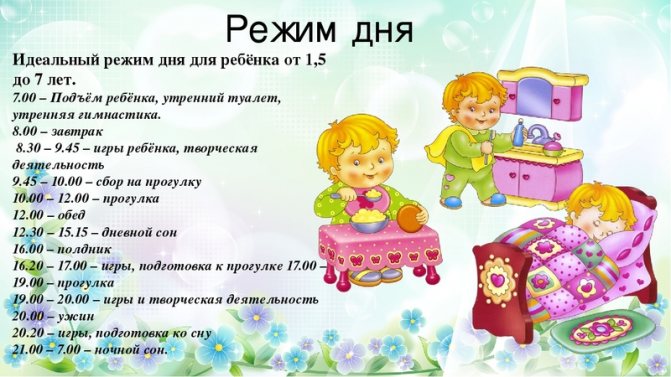
You should accustom your son or daughter to a daily routine from a very early age. This will form a habit that can stay with them for life. Children under 6 years of age adapt much more easily to the established daily routine, so it is recommended to create it during this period of life.
Main advantages
Having a preschooler's daily routine at home has many benefits. They must be taken into account before starting to draw up a daily regimen. This will help prepare the ideal option for the child, which will become an integral part of his life. The main advantages of the daily routine are the following:
- Compliance with the prescribed rules has a positive effect on the health and general condition of the baby. Every day at the same time he receives the necessary amount of sleep, food, fresh air, as well as physical, mental and emotional stress.
- Careful adherence to meal times leads to improved functioning of the digestive system and a reduced likelihood of developing problems with the gastrointestinal tract.
- A balanced daily routine strengthens the child’s immunity. At a subconscious level, the body gets used to it and adapts to certain actions. As soon as lunch time comes, appetite appears, the moment of sleep comes - drowsiness occurs.
- A proper routine helps not only children, but also their parents. Adults can plan an event knowing that their child will be doing a specific activity at that time.
- Children who follow a routine are considered more confident and calm. Routine brings certainty to their lives and eliminates the anxiety associated with the unknown.
- Kids who are accustomed to the established routine quickly become independent, since they know exactly what needs to be done at one time or another.
- All educational institutions operate according to certain rules, so children who follow a daily routine adapt to them much faster. This allows you to improve your ability to learn and remember information.
- Daily routine becomes the basis of self-discipline. This is a very important quality that will help a child make an easier transition from childhood to adulthood.
Why do we need a regime?
In a situation where there is no regime, the child may experience:
- hyperactivity
- hyperexcitability
- memory impairment
- decreased performance
- fast fatiguability
- frequent respiratory diseases
Why is this happening? The daily routine for a baby is not only a convenience for the parent or an adult whim that encourages the child to accustom himself to a strict daily routine. The habitual regime reinforces the formation of biorhythms and conditioned reflexes, preparing the body to perform habitual functions, such as sleep, eating, mental activity, and rest.
In addition, adherence to the regime has a positive effect on physical health, as the regime strengthens the immune system. In preschool institutions, the daily routine is strictly observed. But when bringing a preschooler home, parents do not always adhere to the routine, forgetting to put the baby to bed on time in the flow of evening worries, which leads to lack of sleep and, consequently, problems with waking up in the morning.
Approximate daily routine in a regular preschool educational institution
The daily routine in kindergarten consists of:
- diet, namely the time and number of meals;
- daytime sleep;
- walks;
- children's reception time;
- games and activities.
Teachers accept children to the kindergarten from the moment it starts working until 8 o'clock in the morning. The period while the reception lasts is a time for independent games in the group room or on the playground in the warm season. Before breakfast, time from 8.00 to 8.20/8.30 is allocated for morning exercises with a teacher or physical worker and for preparing for breakfast.
Morning classes
Starting from 9.00, classes are held for children aimed at helping them learn about the world around them, develop their speech skills and become familiar with the basics of mathematics. Teachers are responsible for conducting classes. They must prescribe an activity plan in advance in order to meet the allotted time. In addition to the teacher, a music worker and a physical educator can also work with the kids.
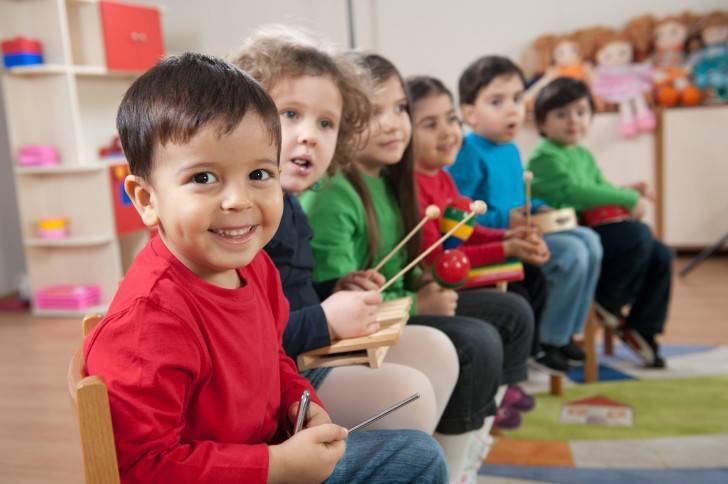
In addition to regular group classes, children can visit the pool 2 times a week, if available. In senior and preparatory groups, additional classes with a speech therapy focus are also organized, in which children train their speech. Only a speech therapist teacher is required to conduct them.
The duration and number of classes depends on age. For younger preschoolers, there are 2 classes a day, one before bedtime, the other after. In the middle group, the teacher works with the kids twice a day for a total of 10 hours. For older preschoolers, the number of classes increases to three, and their duration also increases.
Between classes there should be mandatory breaks when the children rest and move. This is the only way to keep your child active and cognitively active throughout the day.
Walks and naps
After classes are over and the children have had their second breakfast, it's time for a walk. In the nursery, the walk begins earlier than in other groups, and therefore also ends earlier; the children in them are the very first to have lunch. Since children go to the nursery group at 2-3 years old, taking into account the characteristics of a small body, wakefulness time is reduced, and daytime sleep, on the contrary, becomes longer.
With age, the child’s period of activity increases, thereby the baby’s body gradually prepares for school and the regime in it. In the middle group, walks usually last until 11.30-11.50, and in the preparatory group - up to 12.15-12.30. After returning from the street, the children will have lunch and a nap. The room where children sleep should be ventilated in advance, and the beds should be prepared for bed. The youngest go to bed at 12.30, the oldest at 13.00-13.15.
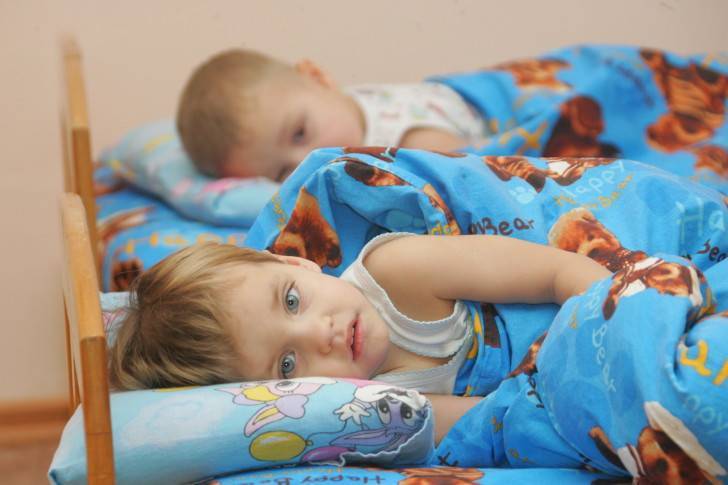
Afternoon
The rising time in kindergarten is the same for all groups. The children are woken up at 15.00, followed by washing, changing clothes and an afternoon snack. In the younger groups, after this, a second general education lesson is held, in the middle and older groups it is time for the children to play independently, read, cartoons or attend clubs that are available in the institution.
Evening meal times may vary depending on the schedule. After dinner, the kids usually go out for a walk again, where their parents gradually begin to come for them. In winter, the second walk does not last long, so the children are taken home to the group premises.
Correct daily routine for a 3 year old child
hope lutai
Correct daily routine for a 3 year old child
CONTENT:
Peculiarities of age Main routine moments What to fill the day with? Standard daily routine
At the age of three, the child becomes more active. He needs a lot of energy for games and cognitive activities, communication with peers. To do this, it is important to provide him, first of all, with adequate day and night rest and proper nutrition . What should be the daily routine for a 3 year old child ?
FEATURES OF AGE
At 3 years old, the child enters a new stage of development. He becomes a member of society, so communication with his parents is no longer enough for him. Communication with peers is of great importance. If a child does not yet attend kindergarten, he needs to be provided with communication with other children on the playground. You can enroll him in an early development group so that he gradually gets accustomed to children's society. If the baby went to preschool, he will have to be put to bed and woken up early in the morning. Find out the daily routine of the kindergarten your baby will attend, and gradually teach your child to sleep , eat, and stay awake at the right time. This transition can take up to six months, so you need to take care of it in advance. Now the baby is already able to stay awake for about 5–6 hours, his need for rest is slightly reduced. So, daytime sleep is now left alone and can last about 1.5–2 hours. But it must be present - while the child still cannot do without daytime rest. This situation will continue until 6–7 years. The baby's physical activity increases significantly. He already overcomes obstacles with ease, can ride a bicycle, swing, run and jump for a long time, climb onto heights, and jump off. old child’s routine should include enough time for active games and physical activity.
MAIN MOMENTS
The daily need for rest for three-year-olds is about 11 hours: 9 are for night sleep, approximately 2 hours for daytime sleep. It is best to put your child to bed after lunch , when he is tired enough after a morning walk. It is advisable to organize a night's sleep no later than ten in the evening. It is important that he sleeps 9 hours before 7 am in order to be on time for kindergarten if he goes there (or to get used to this routine)
.
-year-old child eat at least 4 times. This includes breakfast, lunch, afternoon tea and dinner. Products must provide the child with the necessary supply of energy and nutrients so that he can be physically and mentally active during the day, and therefore develop properly . If the weather permits, you need to walk outside for at least 4 hours a day: before lunch and before dinner. At the same time, during the warm season, all free time should be spent outdoors. This will have a beneficial effect on the baby’s appetite, sleep and overall development.

IT IS IMPORTANT!
Try to get your baby out of the habit of snacking between meals. Otherwise, he simply will not be hungry at the right time. It is especially harmful to snack on flour or sweets. Explain to your relatives that you don’t need to feed your child cookies or chocolates to win his favor. There are more useful things for this. For example, fun games, songs or dances.
WHAT TO FILL YOUR DAY?
Let's start with the fact that the day of a three-year-old child should not go “point by point”
from waking up to going to bed.
There is always free time between meals and bedtime. Therefore, it is important to know what and when you can do with your child . After waking up, you need to teach your baby to participate as much as possible in making the crib and folding his pajamas. This will help the child get used to being independent at home. After sleep and before going to bed at night, water procedures are important. In the morning, the child must wash his face and brush his teeth. In the evening, in addition, take a swim. To practice your toothbrush skills, you can hang a visual aid near the sink. To make bathing more fun, take special toys with you to the bathroom. (By the way, these can be ordinary bowls-mugs with which the child will pour water, empty shampoo bottles for “water shooting”
).
Hands must be washed before each meal. Physical activity begins with morning exercises (read more about this here)
.
Charging should last at least 15 minutes and include exercises for the arms, legs, head, and torso. This will help awaken the entire body. To make studying more interesting, you can turn on funny music (for example, from your favorite cartoon)
.
In summer, it is better to do exercises in the fresh air - in the yard or on the balcony. Children at this age learn from the example of their parents, so mom or dad will certainly do the child

During walks, the child should move as much as possible: jump on ladders, logs, slides, jump on trampolines, ride a swing, bike or scooter, run and frolic in the company of other children. Free time between walks, meals and sleep should not be “empty”
.
The child can play independently (draw, do construction, sculpting, or together with his parents, including educational games. It will not be superfluous to involve the baby in household chores. Let him help his mother wipe the dust, clear the table, put the laundry in the laundry , disassemble after drying. During such work the child will unobtrusively get acquainted with many household appliances, the mother will tell him how they work, what they are needed for. And this is the development of cognitive activity, broadening his horizons and simply getting involved in helping parents with household work. It is important to remember that 2-3 hours before bedtime, activities should become calmer: running and jumping is not advisable now, the baby needs time to calm down and prepare for bed. You can draw, read books, look at and describe pictures, play with mosaics.
THIS IS IMPORTANT!
Buy a calendar that shows the year, month, date, day of the week, and also has the ability to move the numbers. Every morning, talk to your baby about what day it is today. The baby will learn to navigate in time, and awakening will be smoother.
STANDARD DAY ROUTINE
In fact, there is no universal routine for three-year-olds. As for children of other ages, since each family has its own way of life, mom and dad have their own work schedule, they have their own interests, other brothers and sisters in the family also have their own needs. Therefore, routine of one family member should not disrupt the routine of others. When compiling it, you can focus on a certain established standard, which needs to be adjusted to specific circumstances. It looks like this:
- 7:00–7:15 – getting up, water procedures;- 7:15–8:30 – morning exercises;- 7:30–8:00 – time for the baby to study independently or help mom set the table;- 8:00 –8:30 – breakfast;- 8:30–9:30 – educational games with mom;- 9:30–11:30 – morning walk;- 11:30–12:00 – preparation for lunch (changing clothes, washing hands , cleaning up toys that were taken with you, helping mom); - 12:00–12:30 – lunch; - 12:30–14:30 – afternoon nap; - 14:30–16:00 – awakening, child’s independent play within sight of mom ;- 16:00–16:30 – afternoon snack;- 16:30–18:00 – second walk in the park or on the playground;- 18:30–19:00 – dinner;- 19:00– 20:00 – quiet games; - 20:00–20:30 – cleaning toys, cleaning the room; - 20:30–21:30 – bathing, massage, evening bedtime ritual, sleep until morning.
The daily routine is the basis that helps to distribute the necessary activities and actions over the hours, organize them and master this order. And this means order in life, stability, which is so important for the child’s psyche.
Afternoon snack:
Recommended average daily nutritional intake <*> in kindergartens (g, ml, per 1 child)
<*> Deviations from recommended nutritional standards are allowed +/- 5%.
| Name of food product or food group | Number of products depending on the age of the children | |||
| in g, ml, gross <1> | in g, ml, net | |||
| 1 – 3 years | 37 years | 1 – 3 years | 37 years | |
| Milk with m.d.f. 2.5 - 3.2%, incl. fermented milk products with m.d.z. 2.5 - 3.2% <2> | 390 | 450 | 390 | 450 |
| Cottage cheese, curd products for baby food with m.d.zh. no more than 9% and acidity no more than 150 °T | 30 | 40 | 30 | 40 |
| Sour cream with m.d.z. no more than 15% | 9 | 11 | 9 | 11 |
| Cheese of mild varieties, hard and soft | 4,3 | 6,4 | 4 | 6 |
| Meat (1 grade boneless beef/1 grade bone-in beef) <3> | 55/68 | 60,5/75 | 50 | 55 |
| Poultry (chickens 1 category consumption/broiler chickens category consumption/turkey 1 category consumption) <3> | 23/23/22 | 27/27/26 | 20 | 24 |
| Fish (fillet), incl. fillet lightly or lightly salted <3> | 37 | 39 | 32 | 37 |
| Sausages for feeding preschoolers | 5 | 7 | 4,9 | 6,9 |
| Dietary chicken egg | 0.5 pcs. | 0.6 pcs. | 20 | 24 |
| Potatoes: 01.09 to 31.10 | 160 | 187 | 120 | 140 |
| from 31.10 to 31.12 | 172 | 200 | 120 | 140 |
| from 31.12 to 28.02 | 185 | 215 | 120 | 140 |
| from 29.02 to 01.09 | 200 | 234 | 120 | 140 |
| Vegetables, greens <3> | 256 | 325 | 205 | 260 |
| Fresh fruits <3> | 108 | 114 | 95 | 100 |
| Dry fruits | 9 | 11 | 9 | 11 |
| Fruit (vegetable) juices | 100 | 100 | 100 | 100 |
| Vitaminized drinks (ready-made drink) | — | 50 | — | 50 |
| Rye bread (rye-wheat) | 40 | 50 | 40 | 50 |
| Wheat bread or grain bread | 70 | 100 | 70 | 100 |
| Cereals (cereals), legumes | 30 | 43 | 30 | 43 |
| Pasta group A | 8 | 12 | 8 | 12 |
| Wheat flour for baking | 25 | 29 | 25 | 29 |
| Potato flour (starch) | 3 | 3 | 3 | 3 |
| Sweet cream cow butter | 22 | 26 | 22 | 26 |
| Vegetable oil | 9 | 11 | 9 | 11 |
| Confectionery | 7 | 20 | 7 | 20 |
| Tea, including herbal tea | 0,5 | 0,6 | 0,5 | 0,6 |
| Cocoa powder | 0,5 | 0,6 | 0,5 | 0,6 |
| Cereal coffee drink (surrogate), incl. and chicory | 1,0 | 1,2 | 1,0 | 1,2 |
| Baker's yeast | 0,4 | 0,5 | 0,4 | 0,5 |
| Sugar <4> | 37 | 47 | 37 | 47 |
| Table salt | 4 | 6 | 4 | 6 |
<1> In the event of the receipt of new types of food products, including imported goods, or in the case of the receipt of non-standard raw materials, the norms of waste and losses during the technological processing of these raw materials are determined by the preschool organization independently through control studies.
<2> The proportion of fermented milk products should be 135 - 150 ml for children aged 1 - 3 years and 150 - 180 ml for children aged 3 - 7 years;
<3> When using other raw materials, it is necessary to recalculate. Gross weight may vary depending on the raw material and season of the year. When creating a menu, it is necessary to ensure that natural nutrition standards are met in accordance with the data given in the net column.
<4> Including for preparing dishes and drinks; in the case of using industrial products containing sugar (condensed milk, jelly, etc.), the supply of sugar should be reduced in accordance with its amount supplied in the finished product used. RECOMMENDED RANGE
BASIC FOOD PRODUCTS FOR USE IN NUTRITION
CHILDREN IN PRESCHOOL ORGANIZATIONS
One day in kindergarten, rough plan
Most preschool institutions work twelve hours (from 7.00 to 19.00). The daily routine in the kindergarten is drawn up accordingly: starting at seven in the morning, children are received, ending with them going home at seven in the evening.
- Morning. In the morning, the teacher receives children, conducts exercises and organized educational activities (classes) with them. Children also have breakfast in the morning, and in their free time they can play or chat with other children.

- Day. The daily schedule of the kindergarten includes a walk, lunch and nap.

- Evening. Evening is considered to be the time after bedtime and before the children go home. During these hours, children have more time for independent play activities, and the teacher can carve out a few minutes for individual work with this or that child.
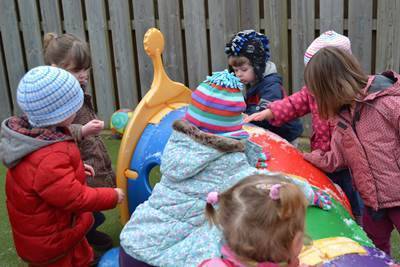
How much time should a child spend in kindergarten?
stay lasts from 7 a.m. to 5 p.m. But it also happens that the kindergarten adapts to the needs of mothers and organizes its programs from 5 to 20 hours.
Regular work of the group usually begins around 7:30 am , because before this time there are not many children with whom, depending on the organization of each kindergarten, the teacher conducts classes. The group's work usually ends around 16:30 , because most parents come to pick up their children.
It is important to note that children should not be in kindergarten for more than 10 hours
At the initial stages , when you just need to accustom your child to kindergarten, the duration of his stay there should be 2-3 hours .
Home mode
What should you do if, for some reason, your child does not and will not attend kindergarten? Sticking to the same regime is a definite thing. True, with some nuances. The first of them is that the baby can be allowed to wake up a little later (since there will be no time needed to travel to the kindergarten). Secondly, you can also put the baby to bed later.

Of course, you can also attract specialists to help (for example, enroll your child in an early development group or with a teacher who will take on the role of a kind of tutor). But if you have confidence in your own abilities, then it is better if the parents teach the preschooler. This way they will have the opportunity to once again (which is not at all superfluous!) demonstrate to him their love, interest in his development and pride in his first achievements.
You will have to do the same things as in the garden: teach writing, reading, drawing, sculpting, dancing, teaching basic mathematical concepts, developing speech, studying nature, playing, developing the child physically (independently or in a sports section), and be sure to accustom him to work. Among other things, mothers are entirely responsible for their child’s diet.
Daily routine in kindergarten in the preparatory group
Older preschoolers are already well organized; they need less time to prepare for breakfast, take a walk, or go to bed. In warm months, children spend more time outside, and in cold months, indoors. In late spring and summer, walks twice a day are recommended - after lunch before lunch, and after afternoon tea before parents arrive. Educational activities, if possible, are moved outside: excursions, themed walks, physical education competitions, work activities.
- Children's reception is from 7 to 8.20 am.
- Morning exercises – 15 minutes, from 8.30 to 8.45.
- Breakfast – from 8.45 to 9.00.
- Independent games - from 9 to 9.10.
- Educational activities - from 9.10 to 9.40, then a break of ten minutes, classes continue from 9.50 to 10.20, again a break of ten minutes, classes continue from 10.30 to 11 o'clock.
- Second breakfast – from 11 to 11.10.
- Preparation for the walk, walk, return to the group - from 11.10 to 12.45.
- Lunch - from 12.45 to 13.10. This period includes: preparation for lunch and eating.
- Sleep - preparation, hygiene, bedtime and naps - from 13.10 to 15.00.
- Getting up, hygiene procedures - from 15 to 15.25.
- Afternoon tea – from 15.25 to 15.40.
- Play time, both independent games and joint activities, is from 15.40 to 16.30.
- Walk - from 16.30 to 19 hours.
- "Traffic rules for preschool children"
- "Healthy lifestyle for preschool children"
- "Outdoor games for preschool children"
New SanPiN for kindergartens 2021 on nutrition
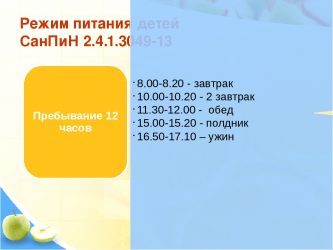
In 2021, the work of preschool institutions (DOU) is regulated by new rules - SanPiN 2.4.1. 3049-13. SanPiN for kindergartens 2019 provides a number of mandatory requirements related to the sanitary sector. In particular, we are talking about the requirements for:
- placement of a kindergarten,
- the equipment used,
- design and content of the preschool educational institution,
- lighting,
- sewerage,
- diet,
- accepting children,
- daily routine, activities and physical education,
- to the staff.
These rules have been developed to ensure optimal conditions for raising children in kindergartens. Much attention is paid to the organization of nutrition for preschool children.
The new SanPiN for kindergartens on nutrition establishes a wide range of requirements for the products used, menu, preparation of dishes, etc. In this article they are discussed in detail.
Menu in a preschool institution
The menu for preschool educational institutions should be developed according to the physiological needs of children of each age group. Responsibilities for checking and approving the menu rest with the head of the institution.
When compiling a diet in a preschool educational institution, the following types of products are allowed:
- meat and fish,
- milk and dairy products,
- chicken eggs,
- butter,
- bakery and confectionery products,
- fruits and vegetables, incl. canned,
- juices, compotes, tea.
SanPiN 2021 for kindergartens prohibits including in the menu:
- wild animal meat products,
- dairy products that have not undergone pasteurization,
- confectionery products with cream based on vegetable or animal fats,
- natural coffe,
- carbonated sweet drinks and mineral water.
Children under one year of age who are bottle-fed should receive formula milk in kindergarten. It is possible to obtain both liquid and dry mixtures for subsequent dilution. The diet for such children is developed individually and takes into account the physiological characteristics of the development of each child. Infant formula supplied to a preschool institution must be supplied only from municipal dairy kitchens and have state registration.
The head of the kindergarten is obliged to inform parents daily about the list of dishes included in the menu and the composition of each dish. A detailed menu for the next day, indicating the names of dishes and the products they contain, is posted separately for each group. The menu should also indicate serving sizes. If there are children in the group who suffer from allergic reactions to certain dishes, then the menu must include substitute products, which the director of the kindergarten also informs parents about in advance.
How to create a menu according to SanPiN automatically?
To do this, it is convenient to use the software module “Nutrition management, diet control” of the system for monitoring the activities of an educational institution. It allows you to create demand menus, cyclic menus, layout menus, and other reporting. Read more about the program here.
Diet
The feeding regime for children in preschool institutions includes four meals a day: breakfast, lunch, afternoon snack and dinner. The standards for dishes and products included in each meal are strictly regulated.
Breakfast:
- hot dish,
- sandwiches,
- hot drink
Dinner:
- snack,
- first hot dish
- second course,
- drink
Afternoon snack
- baked goods or confectionery,
- drink
Dinner
- salad,
- second course,
- hot drink
SanPiN for preschool educational institutions 2021 allows for the possibility of changing the nutrition schedule depending on the age of the children and the length of their stay in kindergarten. So, if a child spends from 8 to 10 hours in a preschool educational institution, then his diet should be as follows:
- breakfast (from 8.00 to 9.00),
- lunch (from 12.00 to 13.00),
- afternoon tea (from 15.30 to 16.00),
- dinner (from 18.30 to 19.00).
Requirements for the daily routine in preschool educational institutions according to SanPiN
The standard daily routine in kindergarten is designed for 12 hours, which the child spends within the preschool walls. Any adjustments are made taking into account climatic conditions, geographical location, and other factors. The regime is drawn up in accordance with sanitary and epidemiological rules and standards SanPiN-10. Key points:
The kindergarten provides four meals a day with a time interval of 4 hours between meals. There are 2 walks in the fresh air - in the morning and after a nap. In total, walking with children requires 3–4 hours. The time spent outside is reduced at temperatures below –15 °C and wind speeds of 7 m/s. According to the daily schedule, nap time is 2–2.5 hours, while the teacher must be present in the bedroom and monitor the sleeping children. It is required to ventilate the room for less than 10 minutes. every 90 minutes If there are no children, arrange ventilation 30 minutes in advance. before they arrive from the street or classes
The air temperature should not drop more than 2–4 °C; it is important to avoid drafts. Bed linen in kindergarten must be changed at least once a week (according to the schedule)
In the cold season, the teacher should meet the children in the morning in the group, in warm weather - outside (at the group site).
Kindergarten classes
In kindergarten, they develop speech skills, broaden their horizons, introduce them to the basics of mathematics and writing, instill a love of creativity and culture, and provide new knowledge. In the absence of medical contraindications, classes are conducted in the following areas:
- physical training;
- music, singing;
- art;
- mathematics;
- development of speech, logic, fine motor skills;
- preparation for school.
In kindergarten, independent games are held, when children communicate with peers, make friends, and relax. There are no more than 3 classes per day in kindergarten, with a break between them of at least 10 minutes. Lesson duration:
- junior group (children 3–4 years old) – 10 min.;
- middle group (4–5 years) – 15 minutes;
- senior group (5–6 years old) – 20 min.;
- preparatory group (6–7 years old) – 30 min.
Lunch is an opportunity to develop independence
In the daily routine between 11 and 11:30 , as a rule, children
- return to the group room
- wash their hands
- and getting ready for lunch.
During lunch, the teacher talks about the rules of behavior at the table, contributes to the formation of a lunch culture, and also develops the independence of the children in accordance with the assessment of teachers and the age of the children. Recommended for children
- Wash your hands properly
- set the table
- and serve food,
- and after eating, take dirty dishes to a specially designated place.
The child’s regime depends on the parents:
Live according to time, do not deviate from the regime unless absolutely necessary. The child may become overexcited and miss morning or afternoon naps. A constant ritual helps to get into a good mood for sleep: changing into pajamas, sitting on a potty, a favorite toy on the pillow, a lullaby, or a fairy tale. When your child wakes up, try to prevent him from lying around or playing in bed. Sometimes, especially on weekends, parents sleep longer than usual and the child's schedule is disrupted because of this. It is not right
We must accept an important rule: the whole family lives according to the schedule, and not just the baby. In this case, forced synchronization comes into play - the child’s biorhythms are adjusted to the life schedule of adult family members
Indeed, living in the same biorhythm means being a family. Of course, the mother does not need to sleep twice during the day, but she can eat at the same time as the baby.
When a baby grows up to one and a half years old, his daily routine changes. Daytime sleep becomes disposable. This is a difficult period and the child’s body must adapt. But these difficulties are temporary, the child himself will choose a way in which it will be easier for him to fall asleep, parents should only carefully monitor him.
It is worth paying attention to the fact that the environment around is familiar, the child should be put to bed at approximately the same time, and you should not deviate from the usual ritual of getting ready for bed. Be patient, as it takes an hour for your baby to fall asleep until he is three years old.
After a year, the child’s nutrition has already been formed and certain habits have been developed. It is served four times a day - a full breakfast, lunch, afternoon snack, dinner. Meal hours are strictly fixed. This helps to instill punctuality in children. In addition, eating meals by the hour has a beneficial effect on digestion and serves as a prevention of diseases of the digestive tract, such as gastritis or bile duct dyskinesia. By the way, these diseases often occur even in preschoolers.
Parents should carefully monitor that in between meals the child does not “kill” his appetite with sweets or crackers. But fruits, juices, and berries should be in the area of constant access so that the baby can eat, for example, an apple whenever he wants. Another important point is planting on a pot. Usually this procedure occurs before bedtime and after sleep, after eating. You shouldn’t delay potty training, especially if parents plan to send their child to kindergarten.
Even a baby can do exercises. After sleep, you need to do a few simple movements with your child. Moving your arms up and down (flapping your wings), jumping, bending over a toy, which the child will do immediately after sleep, will help him finally wake up and return to the normal rhythm of life. Charging usually lasts up to two minutes and should be a game.
What is the importance of a kindergarten routine for a child?
If the daily routine in kindergarten corresponds to the age characteristics of the child, then it will help strengthen the baby’s health and also guarantee his good performance. At the same time, it provides a change in children’s activities and protects them from overwork. A child who gets used to the regime is prepared in advance for new activities, as a result of which they are more fruitful and effective. Children who follow a daily routine have a more stable psyche and are less prone to viral diseases.
When teachers plan the daily schedule in kindergarten, they first of all take into account the fact that the child’s activity and performance varies throughout the day. Children are most active from eight o'clock in the morning to twelve o'clock in the afternoon and from four o'clock in the afternoon to six o'clock in the evening. The minimum performance in children is from approximately two o'clock to four o'clock in the afternoon. Therefore, the first half of the day is devoted to developmental activities, taking into account the fact that children at this time can be actively involved in developmental activities.
| from 8:00 to 12:00 from 16:00 to 18:00 | from 14:00 to 16:00 after 20:00 |
Preschool educational institutions practice full compliance with the daily routine by children. However, parents can give some indulgences to their child on weekends, which cannot but affect his condition later. On Monday it is quite difficult for such children, as they get tired quickly.
Throughout preschool childhood, the regime in kindergarten undergoes only minor changes. The duration of daytime sleep and walking time change slightly.

ABC of the regime
There are rules in all areas of our lives, and they also exist in observing the regime. As we said above, there is a diet for preschoolers, physical activity, sleep, games, and activities.
Diet. If we are talking about proper nutrition, then the regime is most accurately followed in preschool institutions, so it is worth focusing specifically on the organization of nutrition in kindergarten:
- at least 4 times a day;
- a hot meal at least 3 times a day;
- according to daily caloric needs: breakfast 25%, lunch 40%, afternoon snack 15%, dinner 20%;
- according to the daily calorie intake: 5 years - 2000 kcal, 6 years - 2200 kcal, 7 years - 2400 kcal;
- by quantity - you should not give a portion larger than the child usually eats (it is better to add a supplement).
The menu should include meat and dairy products, bread, vegetables and fruits every day.
In terms of time, the mode is built like this:
- breakfast at 8-9 o'clock,
- lunch at 12-13 o'clock,
- afternoon tea at 15-16 hours,
- dinner at 18:30-19:30 hours.
Meal times should be the same on weekdays and weekends.
It is advisable that the last meal be an hour and a half before bedtime.
Mode of physical activity and rest. Every day a child makes many movements, so physical activity means not only physical education, but also active games, sports, movement and relaxation. And here, too, there is a regime that ensures proper physical development.
- The peak of physical activity should occur in the first half of the day.
- Weekly physical activity for children 5-7 years old is 6-8 hours per week, according to SanPiN.
- Morning exercises are required.
- Physical education classes in a preschool institution - 3 times a week: children 5 years old - 25 minutes, children 6-7 years old - 30 minutes.
- Outdoor active games while walking (in bad weather they are replaced by a full set of exercises indoors).
- Physical education minutes between mental activities.
- Exercising after a nap.
- Moderately active games on the second walk.
Moderate physical activity should be observed immediately before breakfast, before mental activities and in the evening before bed.
Sleeping mode. A proper sleep schedule helps restore your baby's mental and physical strength, which was spent on the active part of his day. Not only his psycho-emotional state, but also his physical health depends on how a child’s sleep is organized. Healthy sleep means strong immunity. And now, in order.
- Sleep duration for preschoolers: 5-6 years old - 12 hours, 7 years old - 10-11 hours. But much is individual - depending on temperament and workload, the required time for sleep may increase.
- Morning awakening should occur at 7:00-8:00, it depends on biorhythms and family habits, but you should not wake up later.
- Daytime sleep in children 5-6 years old lasts 1-1.5 hours. At 7 years old, a baby may refuse to sleep, but active children need about 1 hour of sleep.
- Evening bedtime depends on the presence of additional physical or emotional stress. It is recommended that children aged 5-6 years go to bed at 20:30 - 21:00. At 7 years old it is possible to shift the time of falling asleep by half an hour.
Mode of exercise (mental activity). Both kindergarteners and children who do not attend kindergarten are not deprived of developmental activities in preschool age. But like any other activity, the time and number of classes must be correctly distributed and systematized. In other words, the home regime should not differ much from the regime in preschool institutions. The organization of classes in the general daily routine is as follows:
In the morning after breakfast - two or three multidirectional classes. Duration of classes according to age: 4-5 years - 20-25 minutes per type; 6-7 years - 30-35 minutes.
If the walk is cancelled, you can add another creative activity or educational game.
Process nuances
Each type of activity (games, food, walks, learning) must be carried out in compliance with certain nuances. With their help, you can make your child more energetic and cheerful.
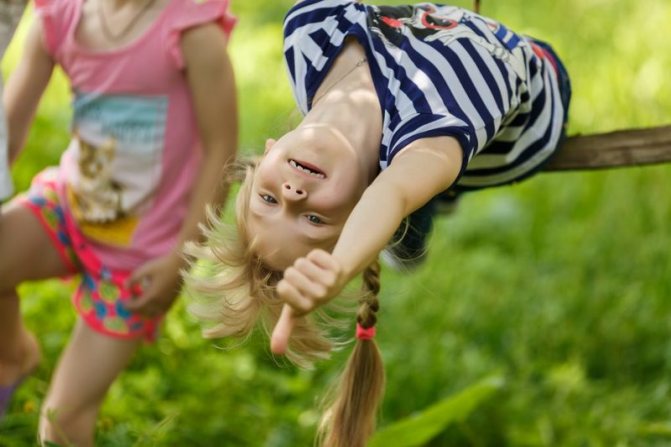
Nutrition rules
In order for a child to grow up healthy and receive all the necessary vitamins, he needs to be provided with proper and balanced nutrition. The best option would be to distribute food evenly throughout the entire waking period. Doctors recommend following the following frequency:
- Children under 3 years old. At this age, it is enough to provide four meals a day (breakfast, lunch, afternoon snack, dinner).
- From 3 to 5 years. Babies belonging to this age category are also recommended to eat 4 times a day. At the same time, light snacks (fruit, ice cream, sweets, desserts) are allowed between meals.
- From 5 years to school entry. Children at this age should be provided with five meals a day as they need more energy to learn and prepare for school.
It is equally important to choose the right products for your daily diet. All harmful ingredients that can negatively affect the functioning of the digestive system should be excluded from the general list.
Key points to consider when choosing products:
- The daily diet must include the following ingredients: butter, milk, stewed or steamed meat, porridge (rice, buckwheat, oatmeal), potatoes, bread, as well as fresh vegetables and fruits.
- About 2 or 3 times a week you need to pamper your child with fish stews, cottage cheese, hard cheese and eggs.
- The preschooler's menu should be constantly changing. It is important that the products consumed are repeated as rarely as possible.
- Meat must be combined with cereals or vegetables.
- It is recommended to give your child a small portion of salad before meals. With the help of this dish, the secretion of gastric juice will be stimulated, which will have a positive effect on appetite.
- Sweet and juicy fruits are best eaten in the evening.
Sleep organization
In order for the baby to fully rest, it is necessary to provide him with appropriate conditions. The optimal duration of sleep depends on age and individual characteristics of the body. Children under 5 years old are recommended to rest at least 12 hours a day (9 hours at night and 3 during the day). Older boys and girls should sleep 1 hour less.
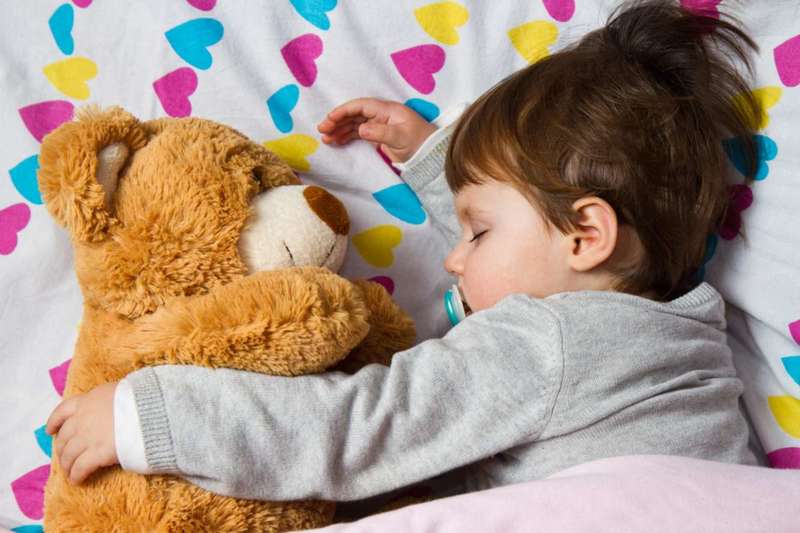
In order for the child to fall asleep quickly, it is recommended to avoid activities that excite the nervous system 1-2 hours before rest. These include:
- noisy games;
- sitting at a computer;
- watching TV.
Very often, preschoolers refuse to nap during the day. You can replace it with some low-active activities (reading, passive games, lying on the bed). Lack of sleep leads to poor mood, health, and learning ability.
Walking and physical activity
To improve health, it is necessary to include regular walks in the fresh air and outdoor games in a preschooler’s daily routine. Doctors recommend walking regularly, except on rainy and very cold days.
Daily walks will help improve:
- metabolic rate;
- functioning of the cardiovascular system;
- resistance to various diseases;
- state of the respiratory system.
A combination of fresh air and physical activity will be beneficial for your baby. It is allowed to perform any actions that will help strengthen health and immunity. It's best to do:
- running warm-up;
- sports games (football, basketball, badminton);
- exercises aimed at strengthening the muscular system (pull-ups on the horizontal bar, push-ups);
- entertaining games.
We recommend reading: Why a newborn baby cries: reasons, methods of calming

